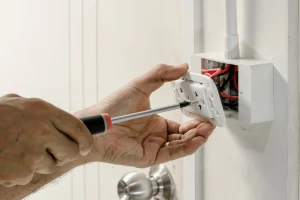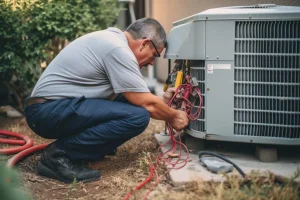Schools face unique challenges regarding electrical emergencies. Regular inspections help identify hazards like faulty wiring and malfunctioning outlets. Staff must be equipped to recognize warning signs, such as flickering lights or unusual odors. A well-organized emergency kit and a clear communication plan are vital for rapid response. However, understanding when to take action and when to seek professional help can greatly influence safety. The next steps in developing a robust emergency electrical repair strategy are essential.
Key Takeaways
- Identify and avoid damaged wiring or appliances, ensuring safety before taking action during electrical emergencies.
- Establish and communicate emergency protocols to prevent panic among students and staff during electrical failures.
- Utilize temporary solutions like resetting circuit breakers or using extension cords to maintain essential power until repairs are made.
- Maintain clear signage to indicate hazardous areas and promote awareness of electrical issues among staff and students.
- Collaborate with qualified electricians for regular inspections and prompt repairs to ensure a safe educational environment.
Understanding Common Electrical Emergencies in Schools
Understanding common electrical emergencies in schools is crucial for maintaining a safe learning environment. Frequent issues include power outages, exposed wiring, and malfunctioning outlets. Power outages can disrupt classes and pose risks if emergency lighting fails. Exposed wiring not only creates hazards but also increases the likelihood of electrical fires. Malfunctioning outlets, often indicated by flickering lights or strange noises, may present a shock risk. Additionally, overloaded circuits can lead to overheating and potential fires. Recognizing these emergencies empowers school staff to act swiftly and effectively. By familiarizing themselves with these scenarios, educators and administrators can foster a culture of safety and preparedness, ensuring that all students feel secure in their learning space. Emergency electrical repair tips are essential for this proactive approach.
Safety First: Precautions to Take During Electrical Issues
When electrical issues arise in schools, taking immediate precautions is essential to guarantee the safety of students and staff. First, it is vital to identify the source of the problem and avoid touching any damaged wiring or appliances. Making certain that all students and staff are aware of emergency protocols can prevent panic and confusion. Establishing a designated meeting area away from the affected zone allows for effective communication and accountability. Additionally, utilizing proper signage to indicate hazardous areas will enhance awareness. Always make sure that a qualified electrician is contacted promptly for professional assessment and repairs. These proactive measures not only safeguard the school community but also foster a culture of safety and preparedness, aligning with the commitment to maintaining a secure educational environment.

Quick Fixes: Temporary Solutions for Electrical Failures
Addressing electrical failures swiftly is essential for maintaining a safe and functional learning environment in schools. Quick fixes can often provide immediate relief in emergencies. For instance, if a circuit breaker trips, resetting it can restore power temporarily. In cases of flickering lights, replacing a faulty bulb might resolve the issue. Utilizing extension cords strategically can power essential devices until permanent repairs are made. Additionally, using tape to secure exposed wires can prevent accidents until a thorough inspection occurs. These temporary solutions are vital for minimizing disruption while ensuring safety. Schools should maintain a well-stocked emergency kit, including fuses and bulbs, to facilitate these quick fixes. Implementing these emergency electrical repair tips fosters a sense of community responsibility and care.
When to Call a Professional Electrician
After implementing quick fixes for minor electrical issues, there are situations where professional intervention becomes necessary. Recognizing these moments can guarantee safety and efficiency within educational institutions. The following scenarios warrant calling a professional electrician:
- Frequent Circuit Breaker Trips: If circuits trip regularly, it may indicate an underlying problem.
- Burning Smells or Discoloration: Any burning odor or charred outlets should prompt immediate professional examination.
- Flickering Lights: Persistent flickering suggests electrical issues that require expert diagnostics.
- Power Outages Affecting Specific Areas: Localized outages may indicate wiring faults needing specialized attention.
Understanding when to seek help is essential for maintaining a safe and functional environment, underscoring the importance of these emergency electrical repair tips.
Developing an Emergency Electrical Repair Plan for Your Institution
To guarantee a swift and effective response during electrical emergencies, developing an extensive emergency electrical repair plan is crucial for educational institutions. This plan should begin with identifying critical electrical systems and potential hazards within the facilities. Next, designated personnel must be trained to handle emergencies, making sure everyone understands their roles and responsibilities. Regular drills can help familiarize staff and students with the procedures, fostering a culture of safety. Additionally, maintaining a clear communication channel for reporting issues promptly is essential. Collaboration with local electricians ensures access to professional support when necessary. By implementing these emergency electrical repair tips, schools can cultivate a secure environment where everyone feels empowered and prepared to respond effectively during electrical crises.
Frequently Asked Questions
What Tools Should Schools Keep for Emergency Electrical Repairs?
In preparation for unexpected electrical issues, schools should maintain essential tools such as voltage testers, wire cutters, insulated screwdrivers, and electrical tape. These items guarantee prompt response and safety during emergency electrical repairs, fostering a secure environment.
How Can We Train Staff for Electrical Emergencies?
Training staff for electrical emergencies involves regular workshops, hands-on drills, and clear communication protocols. Emphasizing teamwork and safety fosters a supportive environment, ensuring everyone feels equipped to respond effectively during critical situations.
What Are the Signs of Electrical Hazards in Schools?
Signs of electrical hazards include flickering lights, warm outlets, unusual smells, frayed wires, and frequently tripped circuit breakers. Recognizing these indicators early can prevent accidents, ensuring a safer environment for all individuals within the institution.
How Often Should Electrical Systems Be Inspected in Schools?
Regular inspections of electrical systems should occur annually to guarantee safety and functionality. Proactive maintenance reduces potential hazards and fosters a secure environment, promoting the well-being of students and staff within educational institutions.
Can Students Help in Emergency Electrical Situations?
In emergency electrical situations, students should not assist directly due to safety risks. Instead, they can support by alerting authorities and following evacuation protocols, fostering a sense of responsibility and community during critical moments.
Conclusion
To summarize, implementing crucial emergency electrical repair tips is imperative for maintaining a safe learning environment in schools. Regular inspections, staff training, and a stocked emergency kit are proactive measures that can greatly reduce risks associated with electrical issues. By establishing clear protocols for addressing emergencies and knowing when to call a professional, educational institutions can guarantee swift responses to incidents, safeguarding the well-being of students and staff while fostering a culture of safety and preparedness.
You May Also Like To Read:

